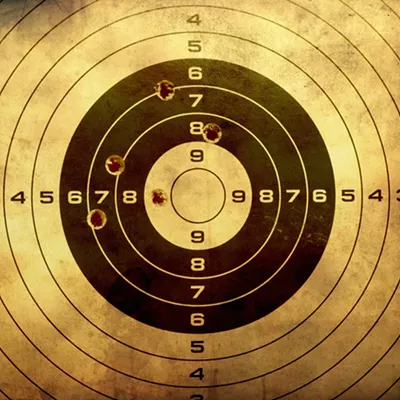It's mostly covered with four-foot-high sagebrush. A half-dozen dust devils are arcing down a bluff in the distance while two hawks glide through the cloudless, 95-degree heat.
I feel I'm back in West Texas as I look through heat mirages. I think of Cormac McCarthy and El Paso. A splash of cold ice water brings me back; we're just two hours southwest of Spokane.
It's hard work, counting each species of grass -- Sandberg, needle, basin wild rye, rabbit rush, cheat and blue bunch -- in among the sage, serviceberries and Russian thistle. We have to write it all down, weigh samples and then, using some nifty formulas, calculate how much food the land could provide for grazing cows.
"It's not exactly ideal-looking land for putting muscle on spooky cattle," I tell one of the ranchers. He's 6-foot-2 and lays a fat mitt on my shoulder.
"You should see this range when it's really dry," he says, laughing and handing me the scales to weigh our grass samples.
It's August and I'm near Ephrata with more than a dozen leather-faced ranchers. They have come to this rangeland management workshop to learn to monitor their land, keep it healthy and optimize productivity. With climate change and foreign beef threatening their very existence, these ranchers need all the help they can get their hands on.
The workshop involves measuring grass levels, writing field notes, shooting digital photos, cataloguing the general botany of the range and inputting data into formulas that can be later crunched into a specialized computer program. It's getting a slice of the land's health and measuring it scientifically that counts.
Charley Orchard is the hired gun who runs the monitoring course. The Washington Cattlemen's Association, Washington Sustainable Food and Farming Network, Nature Conservancy and other groups ponyed up the funds to get him here.
He's a rail-thin Wyoming cattle rancher and the inventor of the Land EKG rangeland health system, which has put him in high demand in recent years. Orchard swears by its potential as both a tool and mindset to reverse consistent overgrazing and destructive management practices that old-school cattle ranchers employ.
Some of these ranchers -- in plaid shirts, broken-down straw cowboy hats and John Deere caps -- are the old-school type. But they also want to learn new techniques because they have only a razor-thin margin for error. An inch of rain in the month of July can make or break an operator.
& lt;span class= & quot;dropcap & quot; & O & lt;/span & rchard carries black canvas EKG bags to various areas of the two-acre plot we're working. Each bag is equipped with the so-called transect tools of the trade -- measuring devices and other things normally used by biologists or archeologists to mark and study areas. The goal is to predict the amount of food available to cattle and make sure the grasses don't get overeaten, killing them.
Orchard repeats the mission statement off his Website several times on this outing, during breaks and in casual conversation. "Creating solar dollars," he says again, shifting the focus of cow poking by enhancing the very thing that makes cows go -- good pastureland, or as is the case in our area, stubby rangeland.
There's plenty of sun out here, and little rain and some snow. The correlation of photosynthesis -- solar energy -- with pounds of meat put on cattle isn't lost on these old timers.
The first two days are long and hot, but we work as a team sitting on five-gallon barrels looking at ways to count the total percentage of live grasses and shrubs to dead litter and exposed dirt and rocks. It's time consuming and monotonous.
But these fellows are good natured and serious all in the same breath, joking around that the journalist -- me -- might be picking up a new profession: "struggling scabland rancher."
These ranchers, who normally would be fixing fences or irrigating hay this time of year, are studiously reading the written materials and taking notes as Orchard takes us through the various life cycles of grasses and the effects of controlled grazing versus overgrazing.
We're on Nature Conservancy land that at first appearance looks barren and devoid of any cattle-raising potential. But, looking closer, I see that it's ecologically diverse, with 14 of the state's 15 species of bats. That many bats mean plenty of insects. And lots of insects mean good plant life.
Orchard, with toothpick clenched between teeth, repeatedly stresses that good cattle management helps grasslands and rangelands transform into balanced and more robust "natural" systems.
"I've seen all sorts of situations where grazing is both good for the land and not good for the land," Orchard says.
The Land EKG provides a full-systems approach. First, there's the grazing index that looks at the frequency or number of bites per grazing period. Then there's a rest/opportunity index that rates the growing period before and following grazing. The last two look at how patchy or uniform plant cover is and then what sort of grazing intensity the rangeland has undergone.
Orchard begins to talk about the roots of his system. While it may seem counterintuitive to the average environmentalist, Orchard and others like Allan Savory -- the father of intensively monitored cattle grazing -- believe cattle ranching can actually put nutrients back into an ecosystem, if it's properly supervised using holistic rangeland management tools like Land EKG. Just think, he says, about what a cow brings to the land -- urine, manure and the incalculable process of breaking up soil and snapping the grasses into production.
One thorn in the side of Western cattle ranchers is the Western Watershed Project, headquartered in Hailey, Idaho, which has used the courts to force ranching off public lands.
"Much of the public-lands grazing industry has demonstrated through time, trial and tribulation that it is either unwilling or unable to work in accordance with the natural environment, the free market, or the law," states Jon Marvel, the director of WWP.
Orchard believes WWP is out to remove grazing and agricultural interests from western landscapes altogether and says his Land EKG program is a good response to the group's concerns about environmental threats.
"WWP states it values healthy lands and wildlife. ... Why don't we in agriculture have that as our mantra? Marvel knows that most land managers don't take the time to monitor what they're doing on the land. And so we [ranchers] lose in court."
Orchard uses tycoon Ted Turner as an example of how important it is to know the health of grasses and other plant life on land. Turner's 1.8 million acres of ranch land were turned into so-called cattle-free reserves. Fences were removed, bison and elk grazed at will, but without deliberate management, the land began to suffer. Dry, brittle gray grass called wolf grass took over, cutting into green and fresh shoots.
& lt;span class= & quot;dropcap & quot; & L & lt;/span & ater, back in the field again, Orchard smiles at the burly and hardened farmers and ranchers as they dribble water on gray topsoil and watch it turn bright green. The land is alive. Orchard knows these ranchers face an unpredictable future, with climate and market fluctuation occurring all the time. But he is hopeful his little invention can help them manage their operations and keep the land -- and their livelihood -- alive and growing.















